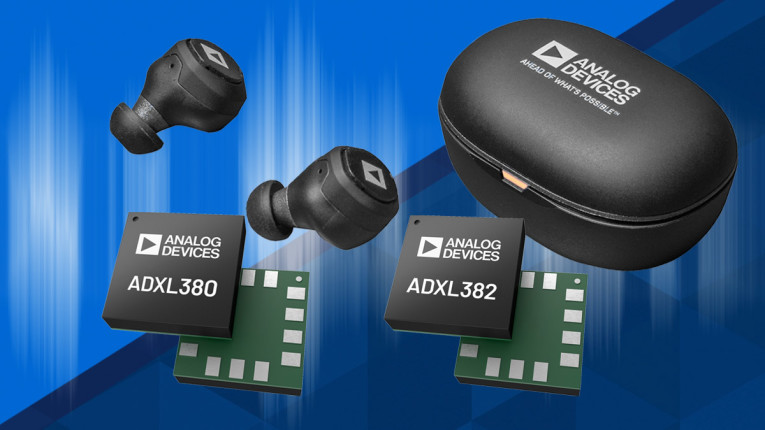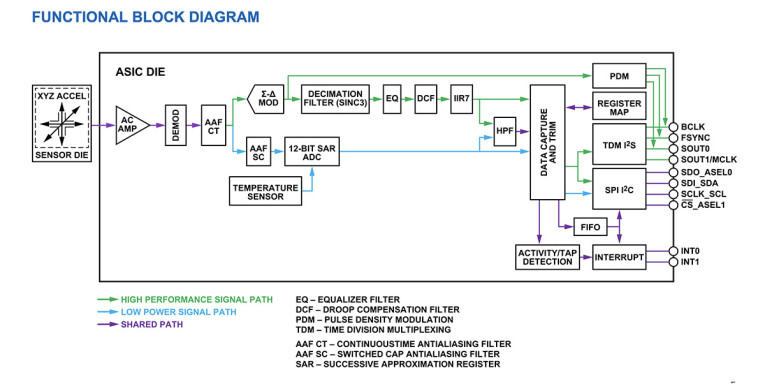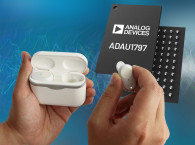
Analog Devices' new ADXL380 and ADXL382 wide-bandwidth, low-noise, low-power, triaxial accelerometers with selectable measurement ranges, provide the needed performance to sense the tiniest of signals ranging from human voice conducting through tissue for true wireless stereo (TWS) earbuds to the vital-signs of equipment, vehicles, and humans for predictive maintenance and analytics. The ADXL380 supports the ±4g, ±8g, and ±16g range options, while the ADXL382 supports ±15g, ±30g, and ±60g range options.
The ADXL380 has a bandwidth of 4kHz, noise density of 27 ug/sqrt.Hz, and requires less than 340mA of current, while the ADXL382 has a bandwidth of 8kHz, noise density of 55ug/sqrt.Hz, and requires less than 520 mA of current. Both sensors offer industry leading noise, enabling accurate measurements in high vibration environments.
In addition to its low power consumption, these accelerometers have many unique features, including a built-in micropower temperature sensor; single, double, and triple tap detection; and a state machine to prevent false triggering. In addition, both models have provisions for external control of the sampling time and/or an external clock. Both devices operate on a wide, 2.25V to 3.6V supply range (or 1.8V supply) and can interface, if necessary, to a host operating on a separate supply voltage. Both are also available in a 14-lead, 2.9mm × 2.8mm × 0.87mm, LGA plastic package.
The ADXL380 and ADXL382 multifunction pin names can be referenced only by their relevant function for either the serial peripheral interface (SPI) or I2C interface, or these pin names can be referenced by their audio function (PDM, I2S, or TDM). While both devices will share many common applications, particularly in wearables, the ADXL380 is the model specifically intended for audio and active noise cancellation (ANC) applications, acting as a bone conduction sensor, and enabling an ultra-low distortion of 0.1% THD+N.
The two products share a wealth of other features including programable filtering, multiple modes of external synchronization for sensor fusion applications, self-test, FIFO, and 5 modes of operation that allow developers to toggle between high-performance and lower power consumption.

For TWS applications, the ADXL380 has a dual signal-path that allows for the simultaneous collection of audio (I2S or PDM) and motion data (SPI or I2C), eliminating the need for a separate accelerometer to detect head activity and motion. Today's earbud designs have two inertial sensors on each side to handle these two use cases separately. The dual signal chains allow for audio information to stream to the audio codec while motion/activity/etc., information can go from the accelerometer to the SoC.
Other features that audio developers will value include the addition of PDM, extreme low latency, and the ability to fully configure the filtering using the codec. This unique integrated individually tuned equalizer provides flat response over the full bandwidth of 4kHz and improves noise density shaping, providing the recovery of more voice information. These features combined also allow the designer to place the accelerometer in any orientation and get the same result.
Both products are currently being sampled by Analog Devices. The Voyager 4 is a reference platform that combines low power, high bandwidth, 3-axis MEMS vibration sensor, with Bluetooth LE, and an AI-enabled microcontroller to deliver asset insights and improved battery life in condition-based monitoring applications. A demo of the ADXL 380 "Pickin' Up Your Body's Good Vibrations" and of the ADXL382 "Voyager 4:Edge AI + MEMS" at Sensors Converge are available here.
Preliminary datasheets are available here:
https://www.analog.com/en/products/ADXL380
https://www.analog.com/en/products/ADXL382
www.analog.com







